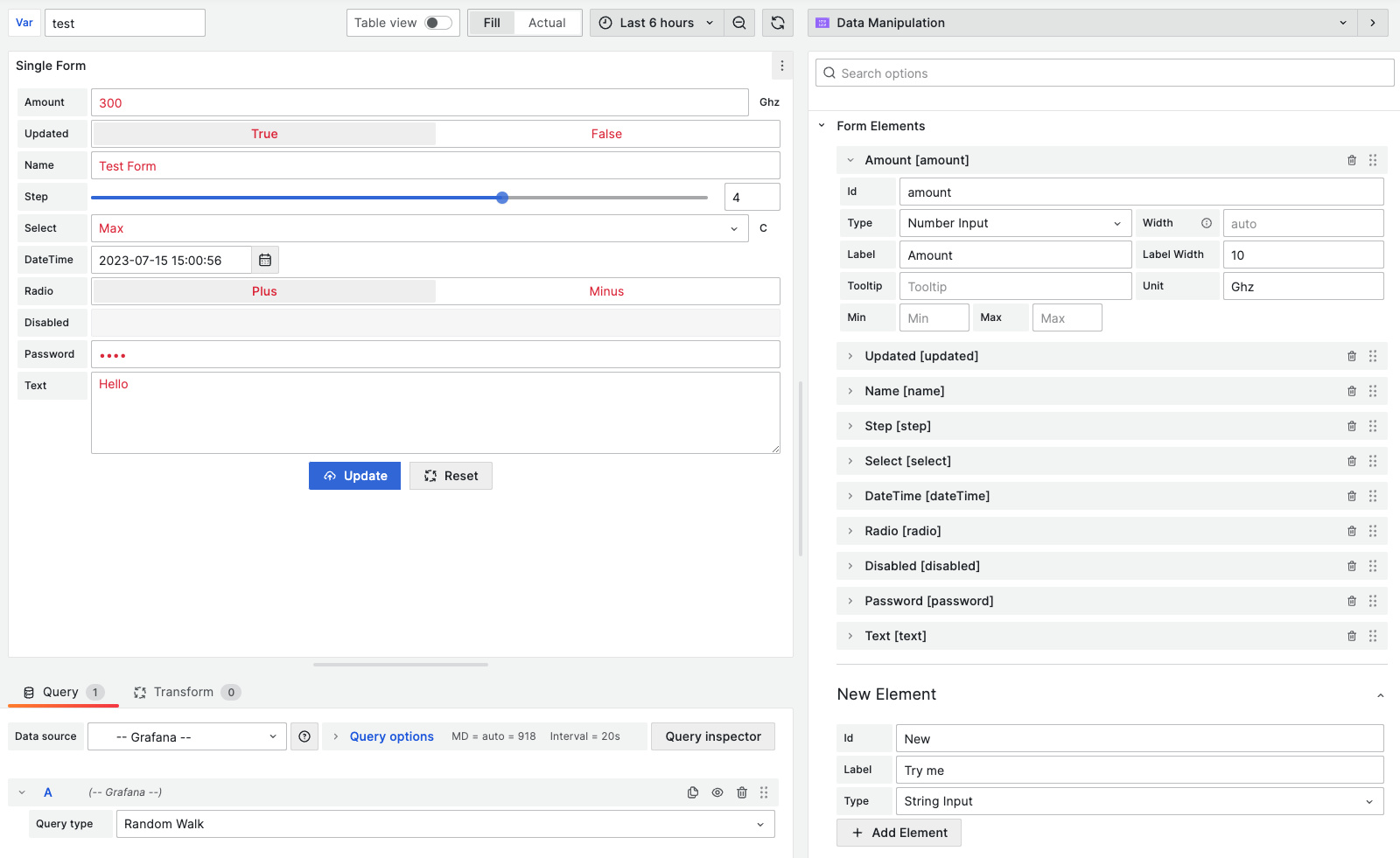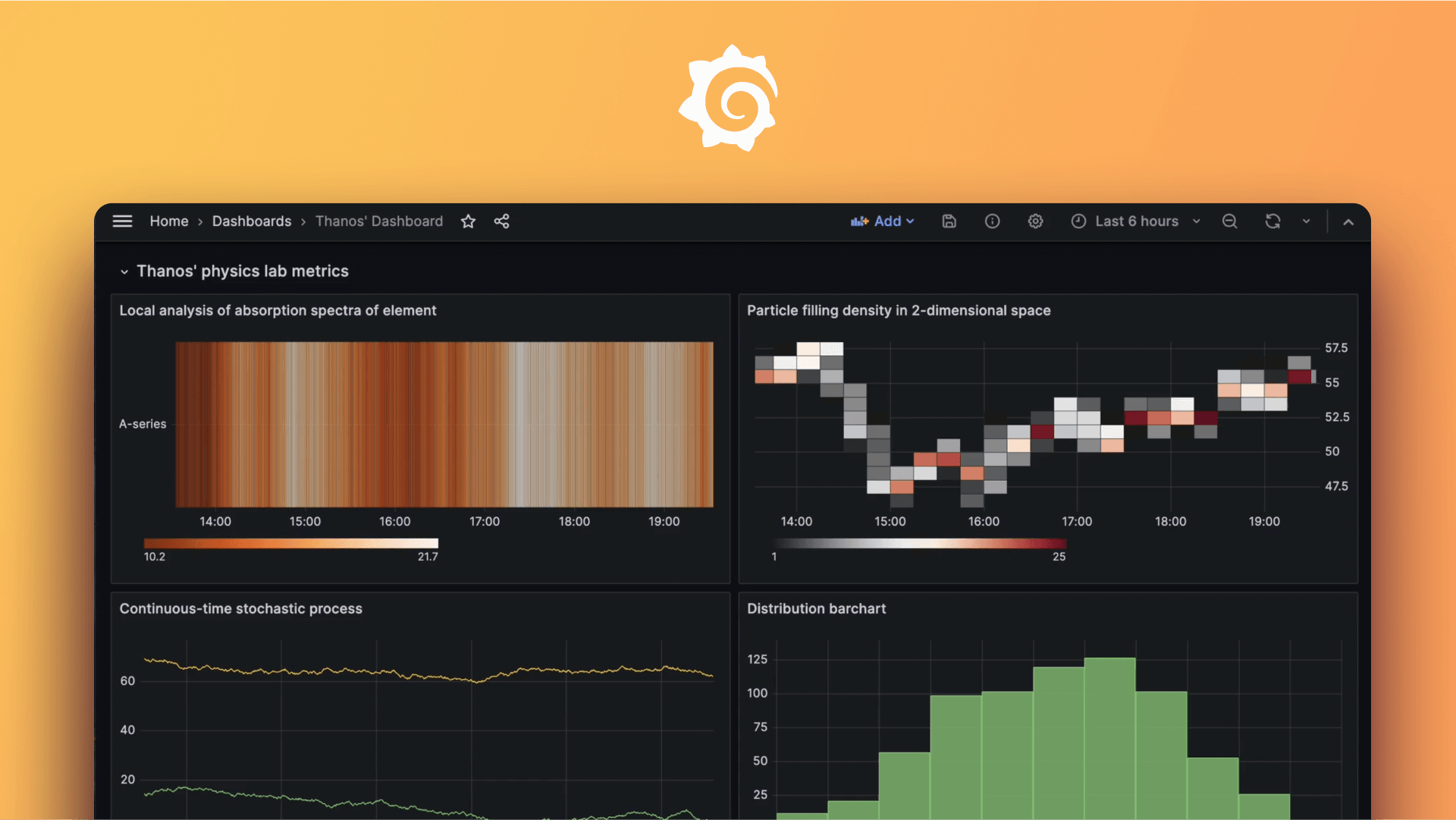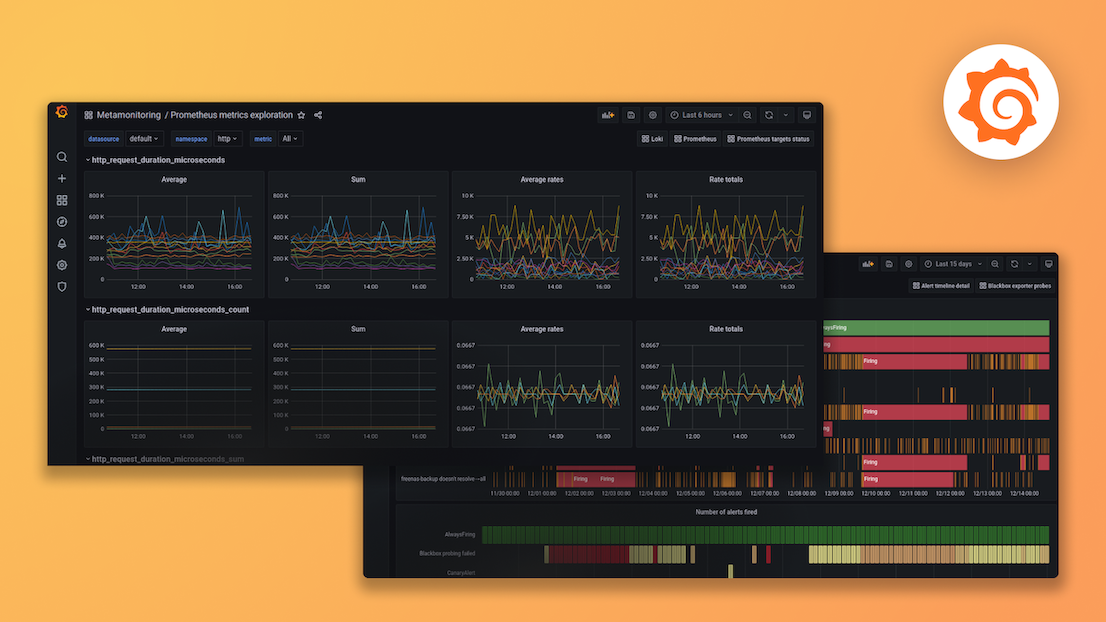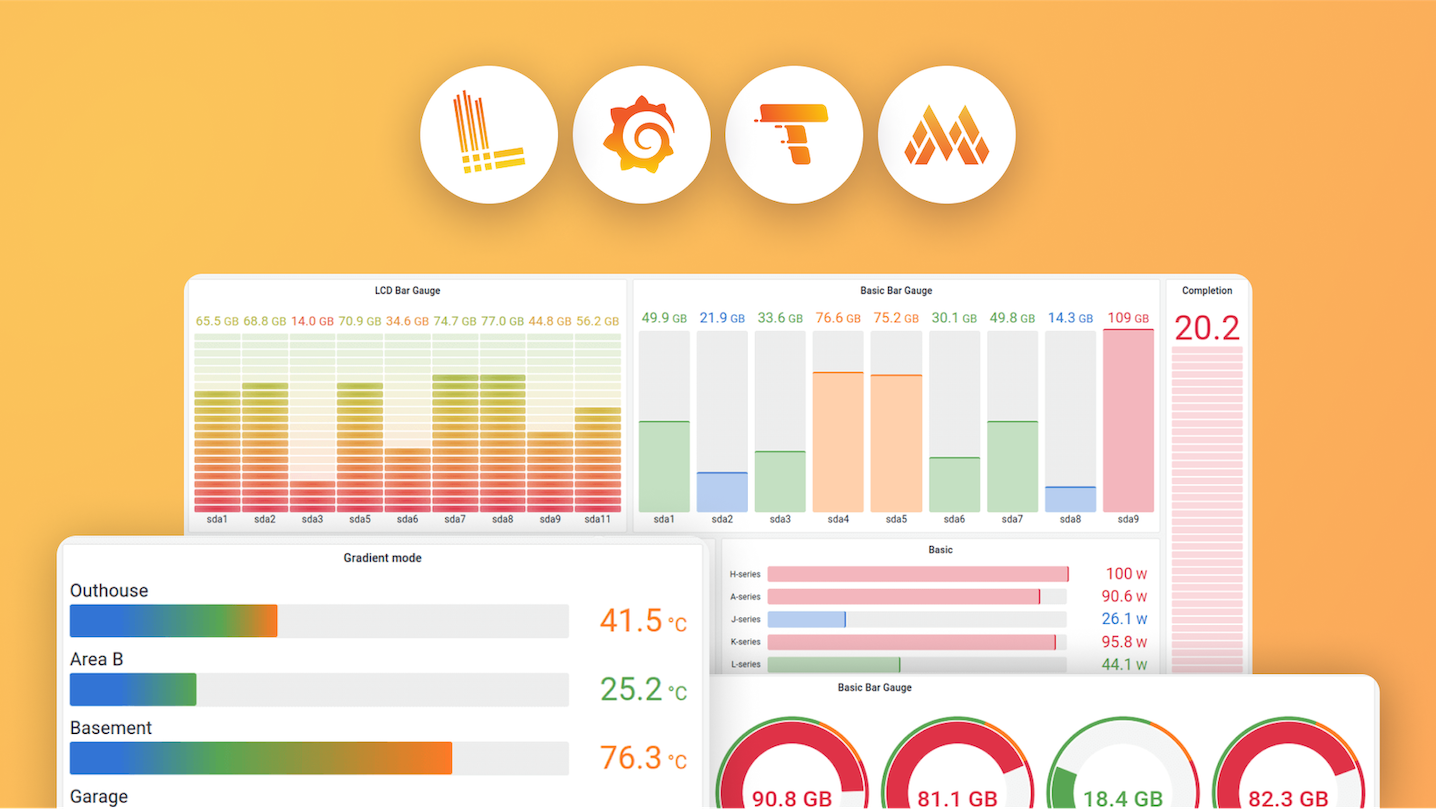Plugins 〉Business Forms
Business Forms
Business Forms Panel for Grafana

Introduction
The Business Forms Panel is a conceptually new plugin for Grafana. It is the first plugin that allows inserting and updating application data, as well as modifying configuration directly from your Grafana dashboard.
Requirements
- Business Forms Panel 4.X requires Grafana 10 or Grafana 11.
- Data Manipulation Panel 3.X requires Grafana 9 or Grafana 10.
- Data Manipulation Panel 2.X requires Grafana 9 or Grafana 8.5.
- Data Manipulation Panel 1.X requires Grafana 8.
Getting Started
You can install the Business Forms Panel from the [Grafana Plugins catalog or use the Grafana command line tool.
For the latter, please use the following command:
grafana-cli plugins install volkovlabs-form-panel
Highlights
- Provides functionality to create customizable forms.
- Supports custom code for initial and update requests.
- Supports API requests, including the
GETrequest to get initial values and theDELETE,PATCH,POST, andPUTrequests to send values updated in the form. - Allows adding request headers to initial and update requests.
- Supports customization of the Submit and Reset buttons as well as the form layout.
- Allows splitting form elements into sections.
- Allows requesting the user's confirmation before running an update request.
- Allows sending all or only updated elements in the request payload.
- Allows displaying success and error notifications through custom code.
- Supports suggestions for available parameters when writing program code in the code editor.
Documentation
| Section | Description |
|---|---|
| Data Flow | Explains the data flow and its specifics. |
| Form Elements | Explains the specifics of form elements. |
| REST API | Explains the REST API architecture and how to use NGINX. |
| Custom Code | Explains how to access plugin options, API responses, form elements, and Grafana services. |
| Features | Explains the plugin features. |
| Servers | Provides examples of API server implementations. |
| Release Notes | Stay up to date with the latest features and updates. |
Business Suite for Grafana
The Business Suite is a collection of open source plugins created and actively maintained by Volkov Labs.
The collection aims to solve the most frequent business tasks by providing an intuitive interface with detailed written documentation, examples, and video tutorials.
Feedback
We're looking forward to hearing from you. You can use different ways to get in touch with us.
- Ask a question, request a new feature, or report an issue at GitHub issues.
- Subscribe to our YouTube Channel and leave your comments.
- Sponsor our open-source plugins for Grafana at GitHub Sponsor.
- Star the repository to show your support.
License
Apache License Version 2.0, see LICENSE.
Grafana Cloud Free
- Free tier: Limited to 3 users
- Paid plans: $55 / user / month above included usage
- Access to all Enterprise Plugins
- Fully managed service (not available to self-manage)
Self-hosted Grafana Enterprise
- Access to all Enterprise plugins
- All Grafana Enterprise features
- Self-manage on your own infrastructure
Grafana Cloud Free
- Free tier: Limited to 3 users
- Paid plans: $55 / user / month above included usage
- Access to all Enterprise Plugins
- Fully managed service (not available to self-manage)
Self-hosted Grafana Enterprise
- Access to all Enterprise plugins
- All Grafana Enterprise features
- Self-manage on your own infrastructure
Grafana Cloud Free
- Free tier: Limited to 3 users
- Paid plans: $55 / user / month above included usage
- Access to all Enterprise Plugins
- Fully managed service (not available to self-manage)
Self-hosted Grafana Enterprise
- Access to all Enterprise plugins
- All Grafana Enterprise features
- Self-manage on your own infrastructure
Grafana Cloud Free
- Free tier: Limited to 3 users
- Paid plans: $55 / user / month above included usage
- Access to all Enterprise Plugins
- Fully managed service (not available to self-manage)
Self-hosted Grafana Enterprise
- Access to all Enterprise plugins
- All Grafana Enterprise features
- Self-manage on your own infrastructure
Grafana Cloud Free
- Free tier: Limited to 3 users
- Paid plans: $55 / user / month above included usage
- Access to all Enterprise Plugins
- Fully managed service (not available to self-manage)
Self-hosted Grafana Enterprise
- Access to all Enterprise plugins
- All Grafana Enterprise features
- Self-manage on your own infrastructure
Installing Business Forms on Grafana Cloud:
Installing plugins on a Grafana Cloud instance is a one-click install; same with updates. Cool, right?
Note that it could take up to 1 minute to see the plugin show up in your Grafana.
Installing plugins on a Grafana Cloud instance is a one-click install; same with updates. Cool, right?
Note that it could take up to 1 minute to see the plugin show up in your Grafana.
Installing plugins on a Grafana Cloud instance is a one-click install; same with updates. Cool, right?
Note that it could take up to 1 minute to see the plugin show up in your Grafana.
Installing plugins on a Grafana Cloud instance is a one-click install; same with updates. Cool, right?
Note that it could take up to 1 minute to see the plugin show up in your Grafana.
Installing plugins on a Grafana Cloud instance is a one-click install; same with updates. Cool, right?
Note that it could take up to 1 minute to see the plugin show up in your Grafana.
Installing plugins on a Grafana Cloud instance is a one-click install; same with updates. Cool, right?
Note that it could take up to 1 minute to see the plugin show up in your Grafana.
Installing plugins on a Grafana Cloud instance is a one-click install; same with updates. Cool, right?
Note that it could take up to 1 minute to see the plugin show up in your Grafana.
For more information, visit the docs on plugin installation.
Installing on a local Grafana:
For local instances, plugins are installed and updated via a simple CLI command. Plugins are not updated automatically, however you will be notified when updates are available right within your Grafana.
1. Install the Panel
Use the grafana-cli tool to install Business Forms from the commandline:
grafana-cli plugins install The plugin will be installed into your grafana plugins directory; the default is /var/lib/grafana/plugins. More information on the cli tool.
Alternatively, you can manually download the .zip file for your architecture below and unpack it into your grafana plugins directory.
Alternatively, you can manually download the .zip file and unpack it into your grafana plugins directory.
2. Add the Panel to a Dashboard
Installed panels are available immediately in the Dashboards section in your Grafana main menu, and can be added like any other core panel in Grafana.
To see a list of installed panels, click the Plugins item in the main menu. Both core panels and installed panels will appear.
Change Log
4.2.0 (2024-07-18)
Features / Enhancements
- Updated Docker Compose and E2E pipeline (#446, #447)
- Improved unit tests (#447)
- Updated Business Forms tutorial (#451)
- Updated the logic for comparing values with the initial values (#454)
- Updated position of Query fields for initial values (#455)
4.1.0 (2024-07-09)
Features / Enhancements
- Updated context parameters migration (#433)
- Updated provisioning files (#433)
- Updated Checkbox list with custom options (#435)
- Updated code defaults to use context properties (#438)
- Updated E2E workflow using Docker (#441)
4.0.0 (2024-07-01)
Breaking changes
- Requires Grafana 10 and Grafana 11
- Data Source requests were updated to use Query Editor.
- Removed non-context code parameters. Please update parameters to use
context.
Code parameters migration guide
- data -> context.panel.data
- elements -> context.panel.elements
- initial -> context.panel.initial
- initialRequest -> context.panel.initialRequest
- locationService -> context.grafana.locationService
- notifyError -> context.grafana.notifyError
- notifySuccess -> context.grafana.notifySuccess
- notifyWarning -> context.grafana.notifyWarning
- onChange -> context.panel.onChange
- onOptionsChange -> context.panel.onOptionsChange
- options -> context.panel.options
- replaceVariables -> context.grafana.replaceVariables
- response -> context.panel.response
- setInitial -> context.panel.setInitial
- templateService -> context.grafana.templateService
- toDataQueryResponse -> context.utils.toDataQueryResponse
Features / Enhancements
- Updated name to Business Forms Panel (#361)
- Added support frontend data sources (#361)
- Updated elected type for a new option (#402)
- Prepared for Grafana 11 (#399)
- Updated Reset button handler (#422)
- Updated Confirmation Window (#420)
- Updated Error handling in code editors showIf, disableIf, getOptions (#410)
- Updated description for Get Options Code (#404)
- Added custom color/background color for elements (#386)
- Added Collapsable Sections (#409)
- Updated to Grafana 11.1 and dependencies (#426)
- Update Date Time query field (#429)
3.8.0 (2024-05-30)
Features / Enhancements
- Added Checkbox List element (#382)
- Updated syntax support in Code Editor (#383)
- Added plugin e2e tests and remove cypress (#390)
- Added server-based form elements example (#392)
- Added input type time (#385)
- Updated hiding/show multi-select element (#389)
- Updated allowed files for file type (#388)
- Added Form validation provisioning dashboard (#411)
3.7.0 (2024-03-10)
Breaking changes
- Requires Grafana 9.2 and Grafana 10
Features / Enhancements
- Added update enabled option and variables examples, fix sync option (#356)
- Added files upload examples and fix form data header (#357)
- Added code parameters with builder and add initial request to element value changed code (#358)
- Allowed to disable columns in confirmation modal (#360)
- Updated dependencies and Actions (#368)
- Added skipping elements hidden using Show If from update payload (#369)
- Add multiple files option (#375)
3.6.0 (2023-01-10)
Features / Enhancements
- Added backend service to custom code (#331)
- Added support for file base64 encoding in payload (#331)
- Added Context parameter to Payload (#331)
Bugfixes
- Fixed element custom options source (#334)
3.5.0 (2023-01-04)
Features / Enhancements
- Added disable if code (#321)
- Updated reset request visibility if reset button is hidden (#322)
- Added code options source for select element (#323)
- Added value changed code (#324)
- Updated to Node 20 (#326)
- Added suggestions for code editors (#327)
- Added reset button confirmation (#328)
3.4.0 (2023-12-14)
Features / Enhancements
- Add ability to disable panel syncing (#298)
- Update ESLint configuration and refactor (#299)
- Update Collapse from @volkovlabs/components (#299)
- Add EventBus and AppEvents to Context (#307)
- Add replacing variables in Payload functions (#309)
- Update to Grafana 10.2.2 and Volkov labs packages (#313)
- Add options migration (#315)
Bugfixes
- Fix draggable control to support upcoming Grafana changes (#314)
3.3.0 (2023-11-21)
Features / Enhancements
- Add Disabled Text Area element type (#243)
- Add Confirmation Window options (#242)
- Add context object to the custom code (#255)
- Add Select Options From Query (#254)
- Add NumberInput component which allows to enter decimals (#291)
- Update to Plugin Tools 2.1.1 (#292)
- Use Grafana Access Policy to sign plugin (#292)
- Update to Grafana 10.2.1 (#292)
- Update ESLint configuration (#294)
- Add Autosize Code Editor (#295)
- Add Data Source option for Reset button (#296)
- Add Link Element (#297)
Bugfixes
- Allow to enter zero value in number field (#288)
3.2.1 (2023-09-07)
Features / Enhancements
- Add backward compatibility for option id (#244)
3.2.0 (2023-09-06)
Features / Enhancements
- Add min and max date for date time element (#225)
- Map Data Source values to elements (#224)
- Update element Show If to support variables (#230)
- Add clearing errors before initial and update requests (#232)
- Add URL encode to variables (#231)
- Allow empty section name (#228)
- Add Query Field Picker for Initial Request (#227)
- Add File element type for File Upload (#229)
- Add converting option value to string and number based on type (#233)
- Add loading states for Initial, Update and Reset button actions (#234)
- Add support for asynchronous custom code (#234)
- Update Query and Data Source initial request (#237)
- Add icons for radio and select options (#238)
3.1.0 (2023-08-13)
Features / Enhancements
- Update jest selectors to use npm package (#209)
- Add onChange to update elements in local state within custom code (#214)
- Update ESLint configuration (#215)
- Add Multi Select element (#217)
- Add conditional element visibility (#219)
- Add custom payload code editor (#220)
- Add custom reset code editor (#221)
- Add Data Source request (#222)
3.0.0 (2023-07-15)
Breaking changes
- Requires Grafana 9 and Grafana 10.
- Form Elements are kept in the local state and not saved in the dashboard by default.
- Local states and elements refactoring may introduce breaking changes. Please test before using in Production.
Features / Enhancements
- Update Documentation for API Servers (#149)
- Update to Grafana 10.0.0 (#165, #172, #184, #200)
- Add Hidden option to String element (#171)
- Add E2E Cypress testing (#180)
- Increase Test Coverage and update Test library (#181, #183, #185)
- Update Form Elements to delay save changes with auto-save (#186)
- Migrate to Plugin Tools 1.5.2 (#187, #192)
- Update to Node 18 (#188)
- Update constants and E2E tests (#190)
- Update Form elements to use local state (#191)
- Add notifyWarning() function (#201)
- Add drag and drop for elements editor (#202)
- Remove Grafana 8.5 support (#203)
- Add running initial request on initial updates (#205)
- Add vertical layout orientation (#206)
2.8.0 (2023-03-16)
Features / Enhancements
- Add String, Number Type for Select and Radio options (#120)
- Add Lookup options for Disabled element (#121)
- Add Server API with MYSQL for Feedback Dashboard (#125)
- Update to Grafana 9.3.1 (#129)
- Add Option for DELETE request (#130)
- Add "Buttons only" Layout to do GET/POST/DELETE requests (#131)
- Update README and move Documentation to docs.volkovlabs.io (#132)
- Update README and Documentation (#134)
- Refactor API Servers (#128)
- Update CI and Release workflows (#145)
- Update to Grafana 9.4.3 (#146)
- Add NoPadding to remove extra padding around and make it configurable (#146)
- Update README and Documentation (#147)
Bug fixes
- Fix Password and Boolean elements confirmation (#120)
2.7.0 (2022-11-10)
Features / Enhancements
- Update to Grafana 9.2.2 (#113)
- Update CI to upload signed artifacts (#116)
- Allow to send all or updated only values in Payload (#116)
- Add Initial values parameter to Update Request parameters (#117)
- Add Status notification after submit form (#98)
- Add Monaco Code Editor suggestions for available parameters (#88)
2.6.0 (2022-10-23)
Features / Enhancements
- Add Compatibility Check Workflow (#92)
- Update to Grafana 9.1.6 (#92)
- Add Custom Code to update variable after update request (#106)
- Add Number Input and Slider min, max validation (#95)
- Initialize element value from a Data Source query (#105)
- Update CI to Node 16 and Synchronize with Release workflow (#109)
Bug fixes
- Initial GET request date time formatting (#99)
2.5.0 (2022-09-10)
Features / Enhancements
- Add Request Header check (#85)
- Expose
initialRequest()in Custom Code to reload panel (#89) - Set
jsonas response data from Initial Request (#90) - Update to Grafana 9.1.4 (#91)
2.4.0 (2022-08-31)
Features / Enhancements
- Update to Grafana 9.1.1 (#72)
- Explain how to use Dashboard Variables in README (#73)
- Add onOptionsChange in examples to update the panel (#75)
- Add variables in URL to call from form elements (#78)
- Add Custom Update Request to README (#79)
- Add Deno Deploy Playground server and dashboard (#80)
- Add "How to Manipulate Data using Grafana dashboard" video in README (#80)
- Show Title instead of Id in the Confirmation Panel (#81)
- Avoid showing confirmation for disabled elements (#77)
- Improve Test Coverage (#21)
2.3.0 (2022-08-11)
Breaking changes
- Signed as Community Plugin.
Features / Enhancements
- Update Sample code in README (#67)
- Updated to be included in the Grafana Marketplace (#68)
2.2.0 (2022-08-09)
Features / Enhancements
- Update to Grafana 9.0.6 (#63)
- Allow to get Elements Initial Value and Configuration from Data Source (#22)
- Update Alert when no elements defined (#66)
Bug fixes
- Number Slider is not updated properly (#18)
2.1.0 (2022-07-17)
Features / Enhancements
- Rebuild based on 9.0.3 (#58)
- Automatic Code Editor Formatting (#59)
- Explain Custom code in Readme (#60)
- Update YouTube link with tutorial in README #61
2.0.0 (2022-06-17)
Breaking changes
- Requires Grafana 8.3+ and 9.0+
Features / Enhancements
- Rebuild based on 9.0.0 (#53)
1.4.0 (2022-05-30)
Features / Enhancements
- Allow to update Element Width (#50)
- Add Highlight for changed values (#51)
- Add Confirmation before Submit (#52)
1.3.0 (2022-05-22)
Features / Enhancements
- Update Architecture Diagram (#44)
- Changing colors on Submit is not working properly (#43)
- Update layout to have sections for Form Fields (#47)
- Add None Request for Initial and Update requests (#48)
- Add Code Editor Element for Configuration Forms (#23)
1.2.0 (2022-05-19)
Features / Enhancements
- Add Label Width and Tooltip (#39)
- Add Server API with Postgres for Feedback Dashboard (#36)
- Update Input Parameters to Form Elements (#41)
1.1.0 (2022-05-12)
Features / Enhancements
- Added Disabled Element (#24)
- Added ability to move elements up and down (#19)
- Added Split Disabled layout for Input/Output (#27)
- Added Interpolate Variables (#28)
- Added Min and Max for Numbers (#29)
- Added Unit Label (#31)
- Added Header Parameters (#32)
- Added Password Input (#33)
- Subscribed to Refresh Events (#30)
1.0.0 (2022-05-11)
Features / Enhancements
- Initial release based on the Volkov Labs Panel template 1.5.0










